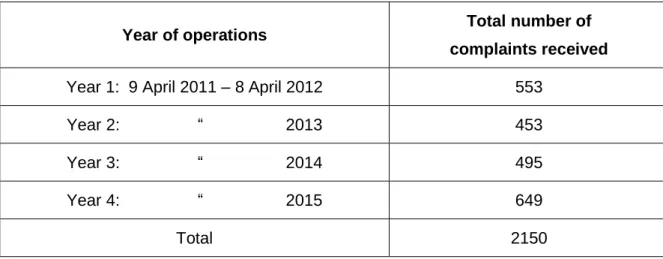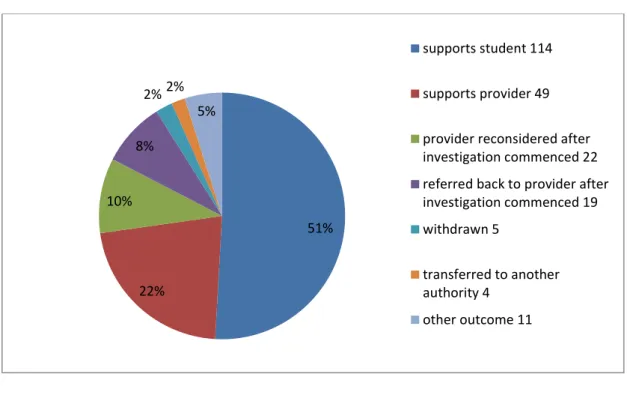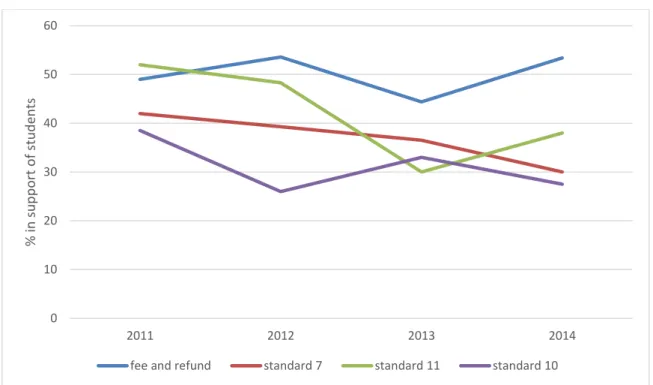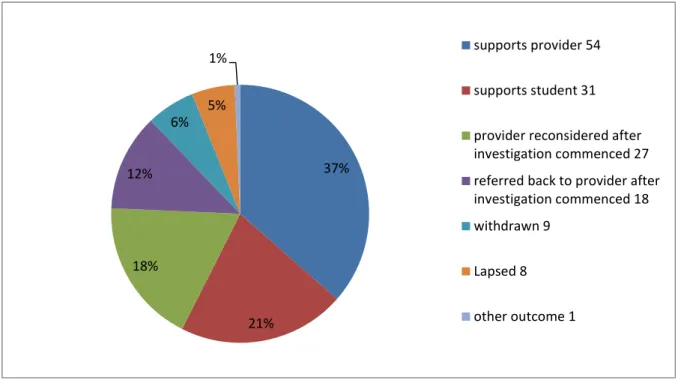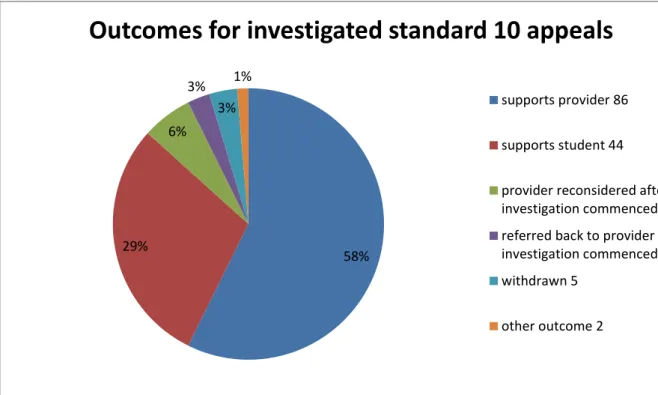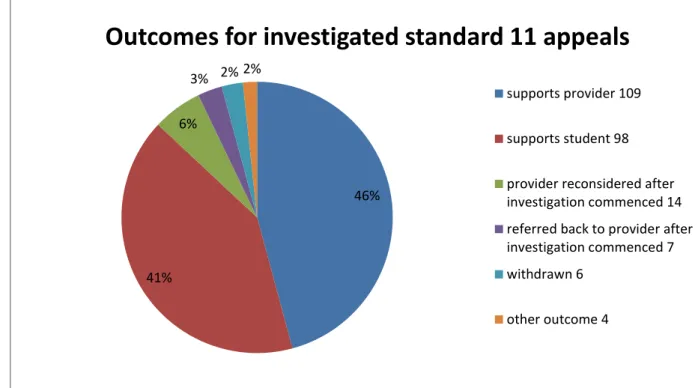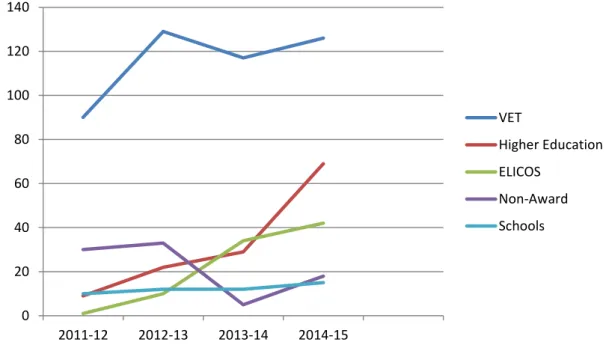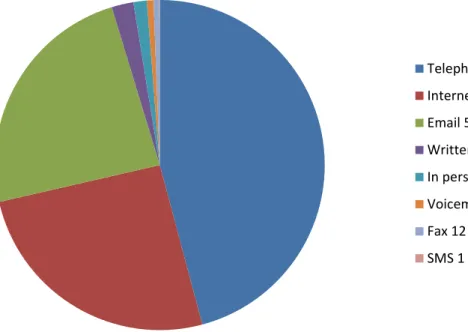However, the Ombudsman may close an inquiry by drawing up a report containing the Ombudsman's views and recommendations. A report may be prepared if the Ombudsman considers that the administrative action under investigation was unlawful, unreasonable, unfair, oppressive or inappropriate. A report can also be prepared to describe an inquiry, including any conclusions drawn from it, even if the Ombudsman has not made any negative findings.
If the recommendations in the report are not accepted, the Ombudsman may decide to submit the report to the Prime Minister or Parliament. The Ombudsman is subject to statutory confidentiality provisions, which may apply for reasons of privacy, confidentiality or privilege. However, as far as possible, the Ombudsman's reports are published in full or in abridged versions on the Ombudsman's website at www.ombudsman.gov.au.
During this period, OSO received 2,150 complaints and external complaints from overseas students from over 68 countries about more than a third of the 911 private registered providers in our jurisdiction2. In the four most common complaint issues, we found student support in nearly 40% of investigated complaints and provider support in 41% of cases.
R OLE OF THE OSO
National Code of Conduct for Registration Authorities and Providers of Education and Training to Foreign Students 2007 (the National Code). CRICOS registered providers must comply with the ESOS framework, which consists of the ESOS Act, legal instruments established under the ESOS Act and the National Code. If a student is dissatisfied with the result or course of the provider's internal complaints and appeals procedure, the provider must inform the student of his or her right to access an independent and external complaints and appeals procedure at minimal or no cost6.
The state and territory ombudsman provides complaints services for overseas students studying with public education providers. The South Australian Office of the Training Advocate acts as an advocate for overseas students and also provides an appeals and complaints service for overseas students studying at public and private registered education providers in South Australia. 6 Standard 8.1 and 8.2 https://internationaleducation.gov.au/Regulatory-Information/Education-Services-for-Overseas-Students-ESOS-Legislative-Framework/National-Code/Documents/National_Code_2007_pdf.pdf.
OSO C OMPLAINT T RENDS , I SSUES AND O UTCOMES
In some cases, after we have started an investigation, the provider reconsiders their decision and decides to support the student. It appears that since 2013 we have seen an increase in support for student attendance (standard 11) and complaints about fees and refunds due to provider errors. However, there has been a recent improvement in provider practices in relation to course progression (standard 10) and provider transfer complaints (standard 7), resulting in fewer decisions in support of the student.
Many complaints about fees and refunds are resolved without the need for investigation because the student provides us with their written agreement and the provider's appeal outcome letter. In other cases, we have found in support of the student because the provider seeks to recover outstanding fees that the written agreement does not expressly permit the provider to charge the student. However, the preamble to Standard 7 states that it is expected that the student's transfer request will be granted where the transfer will not be to the student's disadvantage.
The submission included comments regarding observations of the errors providers make when assessing student requests for provider transfers under Standard 7. We understand that DET is considering Standard 7 provider transfers as part of the current ESOS reform process. If a student subsequently does not achieve satisfactory course progress and/or attendance, the provider must notify the student in writing that it intends to report them.
The written notice must inform the student that he or she may access the registered provider's grievance and appeals process. Our outcome data appear to support this view, as we found that providers correctly complied with Standard 10 course progress requirements in around two-thirds of appeals, compared to only around half the time in Standard 11 attendance appeals. the contractor will make every effort to issue a warning letter as soon as possible if a student's one-day absence takes attendance from a.
In other cases, however, providers make other types of errors, such as miscalculating attendance, which also results in a finding in support of the student. 14 We record the course sector of the student which in some cases may differ from the provider's main course sector.
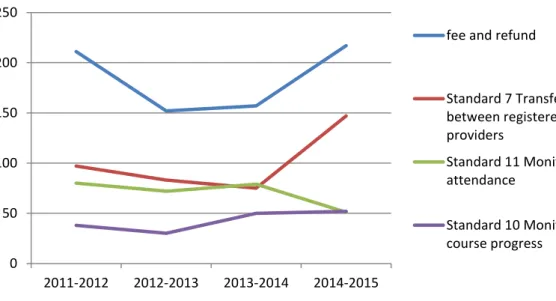
OSO C OMPLAINTS S ERVICES
The first category generally closes on the same day; the second category is finalized without investigation (although contact will usually have been made with the student); the third category was investigated; Category four were investigated where multiple contacts with the provider were required to finalize. The satisfaction that over the same period the average processing time for all categories of complaints has decreased, as Figures 13 and 14 show. The increase in online and telephone complaints may also help reduce the time it takes for a complaint to be initiated to gather the information we need from a student before we investigate.
20 Where multiple contacts with an education provider are required to resolve a complaint, it will be escalated to category four. We made a formal report under s 19ZQ of the Ombudsman Act 1976 to the Minister for Education in relation to a provider who refused to pay a refund to a student for the required four-week period and would not respond to our inquiry into one of its education. agents. Since this time we have used our s 35A publicity powers to report providers of concern directly to regulators.

R EPORTING ON TRENDS AND SYSTEMIC ISSUES
Overseas students are required to have health insurance for the duration of their time in Australia. In each case, the provider had also falsely reported to DET and DIBP that they had arranged coverage. In other cases students were covered for the duration of their course but not for the duration of their stay in Australia.
We also used the complaints to consider more broadly the administration of OSHC by education providers, DET, DIBP, the Department of Health (DH) and the five OSHC insurers. The OSO undertook to liaise with the Council for International Students Australia (CISA) to make overseas students aware of their rights and. In response to our recommendations and in consultation with DET and DH, DIBP has developed a fact sheet which highlights the provider's obligations when arranging cover for overseas students.
In addition, DIBP has changed the information it provides to students to clearly advise students not to enter Australia before their health insurance takes effect. Other steps DIBP has taken include publishing an online blog titled 'Did you know you must have health insurance to study in Australia?'. DIBP said cross-promoting the blog post on its social media platforms and Austrade's Study in Australia website has produced significant results.
In May 2015, we made submissions to the Productivity Commission's research study on barriers to services exports and to DET's Draft National Strategy for International Education. We also meet quarterly with DET, DIBP, TPS, ASQA and TEQSA to monitor and discuss systemic issues, trends and developments in the international education sector. This ensures that serious potential breaches of the ESOS Act or National Code or welfare issues relating to children under 18 are reported to the relevant regulator.
Once we have provided this information, it is up to the regulator to decide what regulatory action, if any, should be taken.
E NGAGING WITH STUDENTS , PROVIDERS AND
We also identify and make recommendations about systemic issues that go beyond the individual student case and affect other students. This enables education providers to address issues, improve the quality of their services to international students and prevent further complaints. We send the provider e-newsletter to all private providers in our jurisdiction, as well as some public providers who have requested to be on our mailing list.
One university distributes our supplier newsletter to all public universities, as the tips and advice apply equally to public suppliers even if they are not in our jurisdiction. We work with the top industry bodies to deliver face-to-face provider workshops and online training webinars.25 We also present at major international education conferences 26 on a variety of relevant topics and are regularly invited to speak to education providers across the globe. Australia. Melbourne, the Office of the Education Advocate (South Australia), the International Education Conciliator (Western Australia), the TPS, ASQA, DIBP and DE.
The purpose of the forum was to identify and discuss trends and issues and promote consistency in the handling of complaints for overseas students. In July 2015, a second form for handling complaints from international students was implemented and we will continue to conduct quarterly network teleconferences of the Complaints Officer. 25 These include EA, ACPET, International Student Advisers Network of Australia (ISANA), Independent Schools Council of Queensland (ISCQ), Association of Independent Schools of South Australia, Study NSW and the Western Australian Private Education and Training Industry Association (WAPETIA).
26 This includes the Australian International Education Conference and national conferences of EA, ACPET, ISANA and the National English Language Teaching Accreditation Scheme (NEAS).
N EXT STEPS
